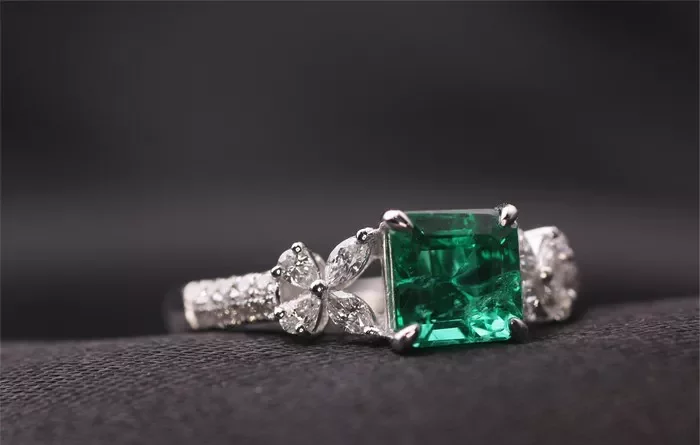When it comes to selecting the perfect diamond, there are various factors to consider, with cost being a significant one. Among the myriad of choices in the diamond market, the emerald cut stands out for its distinctive elegance and allure. However, many wonder: is an emerald cut diamond more expensive? To unravel this question, we’ll delve into a comprehensive analysis comparing emerald cut diamonds with other popular cuts, dissecting the factors influencing their pricing, and shedding light on their market demand and rarity.
Comparison with Other Cuts
Emerald-cut diamonds are renowned for their elongated shape and step-cut facets, offering a unique and sophisticated appeal. When juxtaposed with other popular cuts like round brilliant, princess, and oval, emerald cuts often emerge as a more budget-friendly option. This is primarily due to their lower demand and less intricate cutting process.
Round brilliant diamonds, with their symmetrical shape and maximum light reflection, tend to command higher prices in the market. Similarly, princess and oval cuts, though differing in shape, boast widespread popularity, contributing to their relatively higher cost compared to emerald cuts. Thus, for those seeking a balance between elegance and affordability, the emerald cut presents an enticing choice.
Factors Influencing Cost
Understanding the intricacies of diamond pricing involves examining various factors that impact the cost. In the case of emerald-cut diamonds, several key elements play a crucial role:
Wastage during Cutting: One significant aspect affecting the pricing of emerald-cut diamonds is the wastage incurred during the cutting process. Unlike round diamonds, which can lose up to 60% of the rough stone, emerald cuts typically experience a lower wastage rate, averaging around 20%. This efficiency in utilization contributes to a reduction in production costs, ultimately reflected in the diamond’s price.
Carat Weight: Carat weight is a pivotal determinant of a diamond’s value, with larger stones commanding higher prices. However, the perceived size of a diamond can vary depending on its cut. While emerald cuts may appear larger due to their elongated shape, they often weigh less compared to their round or princess cut counterparts of the same carat weight. As a result, emerald-cut diamonds offer a cost-effective option for those seeking a sizable appearance without the hefty price tag.
Face-Up Size: The face-up size, or the visible surface area of the diamond when viewed from above, greatly influences its overall appearance and perceived value. Despite their lower carat weight relative to other cuts, emerald-cut diamonds often boast a larger face-up size, creating an illusion of grandeur. This optical advantage contributes to their attractiveness and affordability in the market.
Color and Clarity: Color and clarity ratings play a significant role in determining a diamond’s quality and price. While flawless diamonds with higher color grades command premium prices, emerald-cut diamonds tend to mask inclusions better due to their unique faceting style. As a result, diamonds with slightly lower clarity and color grades can still exhibit exceptional brilliance and beauty, making them more accessible to budget-conscious buyers.
Chipping Potential: Despite their allure, emerald-cut diamonds are more susceptible to chipping and breakage compared to other cuts. The elongated corners of the emerald shape are particularly vulnerable to damage if not handled with care. This inherent risk factor may influence pricing, as the potential for additional maintenance or repair costs is factored into the diamond’s overall value.
Market Demand and Rarity
Emerald-cut diamonds occupy a niche market segment, characterized by their understated elegance and timeless appeal. However, they are less prevalent and popular compared to traditional round brilliant or princess cuts. This lower demand, coupled with their unique aesthetic, contributes to their affordability relative to other cuts.
Rarity plays a pivotal role in driving up the value of diamonds. While round brilliant and princess cuts dominate the market due to their widespread popularity, emerald cuts offer a refreshing alternative for those seeking exclusivity. The scarcity of emerald-cut diamonds, particularly in larger sizes or higher quality grades, can elevate their perceived value among discerning buyers.
Expertise in Cutting
Crafting emerald-cut diamonds requires specialized expertise and precision due to their distinctive shape and facet arrangement. Unlike the symmetrical facets of round brilliant cuts, emerald cuts demand meticulous attention to detail to achieve optimal symmetry and proportion. Consequently, the cutting process for emerald diamonds entails additional time and resources, contributing to their overall cost.
Mastering the art of cutting emerald diamonds necessitates a deep understanding of geometry, light dynamics, and gemstone properties. Skilled artisans leverage advanced cutting techniques to maximize the diamond’s brilliance and fire while minimizing potential structural flaws. As such, the expertise and craftsmanship involved in cutting emerald diamonds are reflected in their pricing, making them a testament to fine artistry and precision.
Light Refraction and Brilliance
One of the defining characteristics of emerald-cut diamonds is their exceptional light refraction properties. Unlike the dazzling sparkle of round brilliant cuts, emerald cuts exude a subtle yet mesmerizing brilliance, characterized by broad flashes of light and elegant reflections. This unique play of light accentuates the diamond’s clarity and transparency, enhancing its allure and sophistication.
The cut of a diamond plays a pivotal role in determining its brilliance and sparkle. While round brilliant cuts prioritize maximum light reflection through their multitude of facets, emerald cuts offer a more subdued yet equally captivating radiance. The elongated facets of emerald cuts create a mesmerizing hall-of-mirrors effect, dispersing light in a distinctive pattern that sets them apart from other cuts.
In conclusion, the pricing dynamics of emerald-cut diamonds are influenced by a myriad of factors, including wastage during cutting, carat weight, face-up size, color and clarity, market demand and rarity, expertise in cutting, and light refraction properties. While emerald cuts may be more affordable compared to some other cuts, their timeless elegance, unique aesthetic, and exceptional brilliance make them a captivating choice for those seeking sophistication and value in their diamond purchase.


